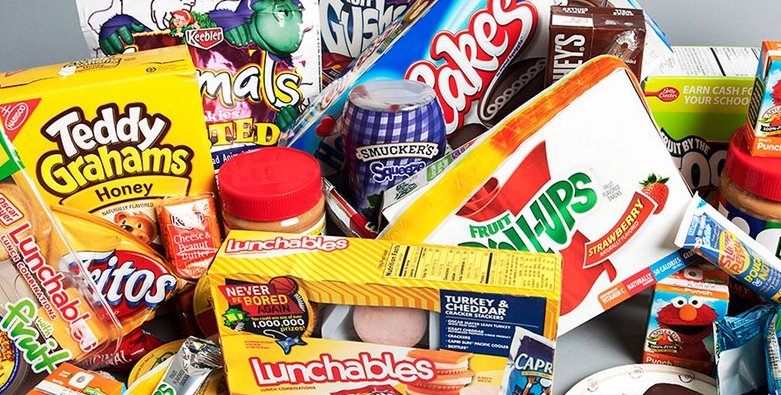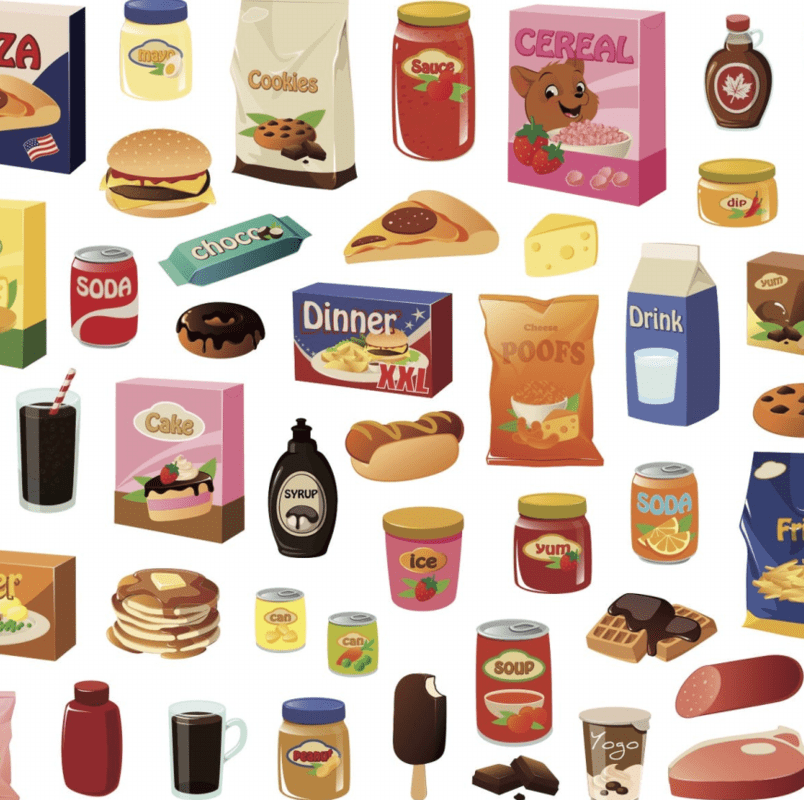What is a processed food

Definition of a processed food
A processed food is a food product that has been altered in some way through a series of mechanical or chemical methods before being made available for consumption.
This process can involve adding or removing certain ingredients, changing the physical form or texture of the food, or using preservatives to extend its shelf life.
Processed foods can be found in many forms such as canned, frozen, dried, packaged and more. Processed food often over-saturated with high level of added sugar, salt, unhealthy fats, and calories, and they can lack the nutrients found in whole foods. These ingridients are often less nutritious than their unprocessed counterparts and have been associated with an increased risk of chronic diseases such as obesity, heart disease, and type 2 diabetes.
4 categories of Processed Foods
Ultra-processed food
These are foods that have been heavily processed and often contain a long list of ingredients. They are often high in added sugars, unhealthy fats, and sodium. Examples include packaged snacks, frozen meals, and sugary drinks.
Processed ingredients
These are ingredients that have been processed and are used to make other foods. Examples include high fructose corn syrup, hydrogenated oils, and artificial sweeteners.
Processed grains
These are grains that have been processed and often have the bran and germ removed, leaving only the endosperm. Examples include white flour, white rice, and pasta.
Minimally processed food
These are foods that have undergone minimal processing, such as freezing or canning, and still retain most of their nutritional value. Examples include frozen fruits and vegetables, canned beans, and dried fruits.
Examples of processed food to avoid
How do you know if food is processed? Some examples of processed foods include:
- Canned soups, vegetables, and fruits
- Frozen dinners, pizzas, and waffles
- Boxed cereal, instant oatmeal, and granola bars
- Packaged snacks such as chips, crackers, and cookies
- Processed meats such as bacon, deli meats, and sausages
- Sweetened beverages such as soda, energy drinks, and sports drinks
- Convenient meals like frozen dinners, canned soups, and instant noodles
- Pre-made sauces, salad dressings, and condiments
- Processed cheese, cream cheese, and cheese spread
- Artificial sweeteners and food dyes
- Baked goods such as cakes, pastries, and doughnuts
- Processed breakfast foods like waffles, pancakes, and toaster pastries
- Processed protein bars and protein powders
Comparison to whole food with examples
Whole foods are foods that have been minimally processed and are close to their natural state. They are often unrefined and contain minimal or no added ingredients. Whole foods are considered to be more nutritious than processed foods and they are often a better choice for overall health.
Examples of whole foods:
- Fresh fruits and vegetables
- Whole grains such as brown rice, quinoa, and oatmeal
- Legumes such as beans, lentils, and chickpeas
- Unprocessed meats such as chicken, beef, and fish
- Nuts and seeds
- Eggs
- Dairy products such as milk, cheese, and yogurt
- Herbs and spices
- Unrefined oils such as olive, avocado, and coconut oil
The key difference
The key difference between whole foods and processed foods is that whole foods are minimally processed, whereas processed foods are often highly processed and contain added ingredients such as sugar, salt, and preservatives. Whole foods are typically more nutritious and provide more health benefits than processed foods. Eating a diet rich in whole foods can help lower the risk of chronic diseases and improve overall health.

How are processed foods made?
Processed foods are made through a series of mechanical and chemical methods that alter the food in some way before it is made available for consumption. The specific methods used can vary depending on the type of food and the desired end product.
Methods used to process foods:
- Canning: Foods are placed in airtight containers and then heated to high temperatures to kill bacteria and other microorganisms. This process also helps to extend the shelf life of the food.
- Freezing: Foods are rapidly cooled to very low temperatures to prevent bacteria and other microorganisms from growing. This process also helps to extend the shelf life of the food.
- Drying: Foods are dehydrated to remove the moisture and extend the shelf life. This process can be done using natural sun or by using dryers.
- Pasteurization: Foods are heated to high temperatures to kill bacteria and other microorganisms. This process is commonly used for milk, juice, and other liquids.
- Fermentation: Foods are exposed to microorganisms such as bacteria or yeast to change the flavor or texture of the food. This process is commonly used to make yogurt, cheese, and fermented vegetables like sauerkraut and kimchi.
- Addition of additives: Many processed foods contain added ingredients such as sugar, salt, preservatives, and artificial colors and flavors. These ingredients can be added to improve the taste, texture, appearance, or shelf life of the food.
- Extrusion: This process is used to create many different types of foods from cereals to pasta, It is used to mix, form, and cook ingredients in one step and also to improve texture, stability, and shelf life.
Nutritional impact of processing
The nutritional impact of processing can vary depending on the type of food and the specific methods used to process it. In general, processed foods are often less nutritious than whole foods because they can lose important nutrients during the processing process.
Some of the most notable nutritional impacts of processing include:
- Loss of vitamins and minerals – Processing can cause the loss of important vitamins and minerals such as vitamin C, vitamin A, calcium, and iron.
- Addition of unhealthy ingredients – Processed foods often contain added sugars, salt, unhealthy fats, and artificial ingredients which can contribute to chronic diseases such as obesity, heart disease, and type 2 diabetes.
- Low in fiber – Whole foods, like fruits, vegetables, whole grains and legumes are rich in fiber, which is essential for maintaining a healthy digestion. Processed foods are often low in fiber, which can lead to constipation and other digestive problems.
- High in calories – Processed foods are often high in calories, which can lead to weight gain and obesity if consumed in excessive amounts.
- Nutrient-poor – Processed foods are often nutrient-poor, meaning that they contain fewer vitamins, minerals, and other nutrients than whole foods. They can also be high in calories and low in fiber, which can contribute to chronic health conditions.
- Artificial ingredients – Processed foods often contain artificial ingredients such as colors, flavors, sweeteners and preservatives. These can be harmful to human health and can cause allergic reactions or other health issues.
The effects of processed foods on health
The effects of processed foods on health can be significant. Some of the most notable effects include:
Increased risk of chronic diseases
Processed foods are often high in added sugars, salt, unhealthy fats, and calories, which can contribute to the development of chronic diseases such as obesity, type 2 diabetes, and heart disease.
Weight gain and obesity
Processed foods are often high in calories, which can lead to weight gain and obesity if consumed in excessive amounts.
Impact on gut health
Processed foods are often low in fiber, which can lead to constipation and other digestive problems. Additionally, certain additives and preservatives used in processed foods may disrupt the balance of good and bad bacteria in the gut, leading to inflammation and other health issues.
Effects on mental health
The specific mechanisms by which a diet high in processed foods may impact mental health are not fully understood. Research suggests that a diet high in processed foods may be associated with an increased risk of mental health issues such as depression and anxiety. Some possible explanations for this association include inflammation, nutritional deficiencies, blood sugar imbalances.
Nutritional deficiencies
Processed foods are often lacking in essential vitamins and minerals, which can lead to nutrient deficiencies over time if they make up a significant portion of the diet.
Risk of food allergies and sensitivities
Processed foods often contain artificial ingredients that can cause allergic reactions or other health issues.
Risk of food-borne illnesses
Processed foods may contain bacteria, viruses, parasites or chemical contaminants that can make you sick.
Tips how to identify processed foods
- Check the ingredients list: Processed foods often contain a long list of ingredients, many of which are hard to pronounce or recognize. The fewer ingredients and the more whole food ingredients the better.
- Look for added sugars, fats, and sodium: Processed foods are often high in added sugars, unhealthy fats, and sodium. Be sure to check the nutrition label for these ingredients and try to choose options with lower amounts.
- Avoid foods with artificial ingredients: Processed foods often contain artificial colors, flavors, and preservatives. These ingredients are often listed on the ingredients label and are best avoided.
- Check the packaging: Processed foods often come in packaging such as cans, boxes, and plastic containers. While not all packaged foods are processed, it’s a good idea to check the ingredients and nutrition label before purchasing.
- Check for a nutrition label: Many whole foods don’t have a nutrition label, while most processed foods do.
- Be mindful of convenience foods: Processed foods often come in the form of convenience foods such as frozen dinners, canned soups, and instant noodles. These foods are often high in sodium and preservatives and low in nutrients.
- Be aware of processed meats: Processed meats such as bacon, deli meats, and sausages are often high in sodium and preservatives and should be consumed in moderation.
How to read food labels
Check the serving size
The information on the nutrition label is based on a specific serving size. Be sure to compare the serving size to the amount you will actually be eating.
Look at the calories
The label will list the number of calories per serving. Be mindful of the total calories you consume throughout the day.
Check the macronutrients
The label will list the amount of carbohydrates, protein, and fat per serving. Be mindful of the total amount of these macronutrients you consume throughout the day.
Check the micronutrients
The label will list the amount of vitamins and minerals per serving. Be mindful of the total amount of these micronutrients you consume throughout the day.
Look at the ingredients
The ingredients are listed in descending order by weight. The first ingredient listed is the one that makes up the largest percentage of the product.
Check for added sugars
The label will list the amount of added sugars per serving. Try to limit added sugars and opt for foods with little or no added sugars.
Check for Sodium
The label will list the amount of sodium per serving. Try to limit your sodium intake and opt for foods with little or no added sodium.
Check for fiber
The label will list the amount of fiber per serving. Fiber is important for maintaining a healthy digestion, Try to opt for foods that are high in fiber.
Check for the expiration date
The label will list the expiration date of the food. Be sure to consume the food before the expiration date to ensure that it is safe to eat.
Tips how to choose healthier options
Eating a diet rich in whole foods and low in processed foods is essential for maintaining good health. Choosing healthier options can help you maintain a balanced and nutritious diet. Here are some tips to help you make healthier choices:
- Choose whole foods: Whole foods, such as fruits, vegetables, whole grains, and lean proteins, are often the most nutritious options. These foods are minimally processed, and are rich in vitamins, minerals, and other nutrients.
- Limit added sugars: Added sugars can be found in many processed foods and can contribute to weight gain and other health issues. Try to limit added sugars and opt for foods with little or no added sugars.
- Limit sodium: High sodium intake can contribute to high blood pressure and other health issues. Try to limit your sodium intake and opt for foods with little or no added sodium.
- Check the ingredients: The ingredients are listed in descending order by weight. The first ingredient listed is the one that makes up the largest percentage of the product. Be mindful of the ingredients and opt for foods with fewer ingredients, and more whole food ingredients.
- Choose fiber-rich foods: Fiber is important for maintaining a healthy digestion. Try to opt for foods that are high in fiber, such as fruits, vegetables, whole grains, and legumes.
- Opt for healthy fats: Healthy fats, such as those found in nuts, seeds, avocado, and olive oil, can help to improve heart health and reduce inflammation.
- Read food labels: Reading food labels can help you make informed choices about the foods you eat. Be sure to check the serving size, calories, macronutrients, and micronutrients.
- Plan your meals: Plan your meals and snacks in advance, this will help you make healthier choices and avoid impulse buys.
- Shop the perimeter of the grocery store: The perimeter of the grocery store is typically where the fresh fruits, vegetables, meats, and dairy are located. These are often healthier options than the processed foods found in the middle aisles of the store.
Choosing healthier options can not only help you maintain a healthy weight, but it can also reduce your risk of chronic diseases such as heart disease, diabetes, and cancer. By taking the time to choose whole foods, limit added sugars and sodium, and read food labels, you can make informed choices about the foods you eat and work towards maintaining a balanced and nutritious diet.
Small changes can make a big difference in your health and well-being, so start today by making healthier choices and take control of your health.









